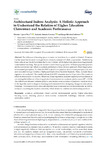Architectural indoor analysis: A holistic approach to understand the relation of higher education classrooms and academic performance

Use este enlace para citar
http://hdl.handle.net/2183/24399Colecciones
- Investigacion (ETSAC) [511]
Metadatos
Mostrar el registro completo del ítemTítulo
Architectural indoor analysis: A holistic approach to understand the relation of higher education classrooms and academic performanceFecha
2019Cita bibliográfica
López-Chao, V., Amado Lorenzo, A. , & Martin-Gutiérrez, J. (2019). Architectural Indoor Analysis: A Holistic Approach to Understand the Relation of Higher Education Classrooms and Academic Performance. Sustainability, 11(23), 6558. doi:10.3390/su11236558
Resumen
The influence of learning space on users has been broadly accepted and tested. However, the literature has focused on single factor research, instead of holistic approaches. Additionally, lower educational levels have been the focus of interest, while higher education is moving towards multi-method teaching. This paper focuses on how learning spaces for different purposes (practice and lecture rooms) may influence academic performance from a holistic approach of learning physical environment perception. For this, the iPEP scale (Indoor physical environment perception) is used and validated through Cronbach Alpha and Exploratory Factorial Analysis. Then, multiple linear regression is conducted. The results indicate that iPEP measures near to 63 percent of the construct, which is structured in six factors. Moreover, linear regression analyses support previous literature concerning the influence of learning physical environment on academic performance (R2 = 0.154). The differences obtained between practice and lecture room in terms of predictor variables bring to the light the need to diagnose learning environments before designing changes in educational buildings. This research provides a self-reported way to measure indoor environments, as well as evidence concerning the modern university, which desires to combine several teaching methods
Palabras clave
Acoustics
Architecture
Visual comfort
Environmental quality
Higher education
Learning space
Learning physical environment
Sustainable buildings
Thermal comfort
Ventilation comfort
Architecture
Visual comfort
Environmental quality
Higher education
Learning space
Learning physical environment
Sustainable buildings
Thermal comfort
Ventilation comfort
Versión del editor
Derechos
Atribución 4.0
ISSN
2071-1050






